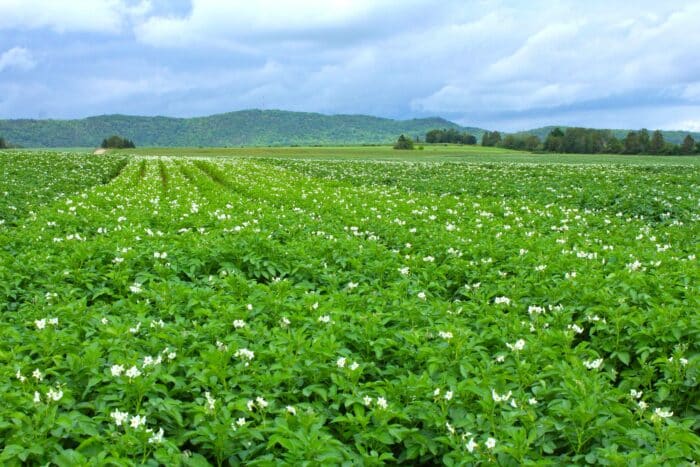The Farm of the Future works to provide new technology, resources and methods to improve yields and farming for McCain growers across the globe.
The regenerative agriculture movement has taken the agricultural world by storm, and McCain Foods has taken its efforts one step further — by 2030, all of the company’s potato products will be made from spuds grown through regen ag practices.
To help them achieve this goal, the Canadian Farm of the Future was born as a testing ground for McCain’s regen ag push. Located in Florenceville, N.B., the farm is composed of 500 acres — 360 acres of cultivated land and 140 wooded and non-productive acres. More than 150 additional acres are also being rented from a neighbour.
The practices that have been implemented on the farm thus far include fall ridging and cover cropping, biodiversity enhancement, controlled traffic farming systems to combat compaction, green manuring through multispecies cover crops and under seeded perennials and livestock integration and rotational grazing to allow for nutrient cycling and reduced fertilizer rates. New chemistries with low environmental impact measured with Cornell University’s EIQ, the planting of flowering strips to attract wild pollinators and bees and soil friendly equipment including the chisel plow and dammer diker are also utilized, explains Manphool Fageria, senior scientist and manager of Canada’s Farm of the Future, in an interview with Spud Smart.

These various regen practices offer an extensive list of potential benefits for growers, such as the saving of topsoil, reduction of compaction and soil erosion, increase of water infiltration, breakdown of the disease and pest cycle, nitrogen fixation and the enhancement of carbon sequestration.
“The industry is facing so many problems, whether it’s weather volatility, losing topsoil yearly, early crop dying or pest resistance to pesticides, high input costs, unavailability of skilled operators or crop yield stagnation. To solve some of these challenges, we have implemented these regenerative practices,” says Fageria.
The farm completed its second successful growing season in 2022 with over 28 plant species planted in different fields to enhance biodiversity and regenerate soil. The soil surface was covered with green vegetation for more than 181 days. The cover crops acted as a source of nutrition for bacteria, fungi, earthworms and additional soil organisms, increasing carbon in the soil, adds Fageria.
For growers, the Farm of the Future provides a resource to look towards when thinking about implementing these practices and efforts onto their own farms.
“When we try something new as a farmer, it can be a risk sometimes. At the Farm of the Future, they are willing to risk it first,” shares Alyre Poitras, a New Brunswick potato grower.
Poitras and his son Paul attended two field days at the Farm of the Future — the first in mid-June of 2022 and their most recent visit in November 2022. They were greatly impressed by the farm, especially by the fall hilling and cover cropping.
“We could see that the soil at the Farm of the Future was nice, rich and full of life just by stepping on it, smelling it or simply by looking at the plant that was growing in it. A plant was constantly growing in the soil, keeping it alive and safe from erosion,” says Poitras.
In the future, the farm will begin implementing more clean energy practices, including solar panels and drip irrigation to optimize water use. Fageria expects the solar panels to be installed by this summer.
Header photo — A flowering potato field at McCain Food’s Canadian Farm of the Future in Florenceville, N.B. Photo: Dave Bailey, McCain Foods
Sponsored by: 
Related Articles
First Growing Season at McCain Farm of the Future a Success
McCain Receives Federal Funds for Farm of the Future
The Regenerative Ag Debate for Growing Potatoes, is it Possible?








